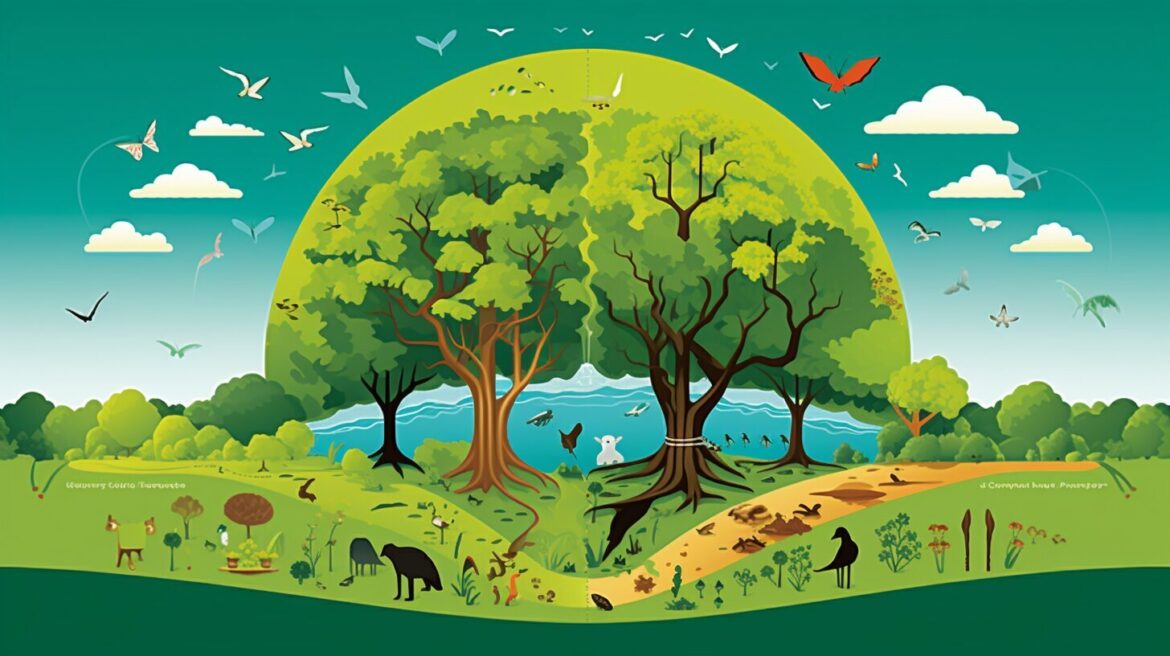Climate change and environmental conservation are two of the most significant challenges facing the world today. As global warming continues to impact ecosystems and biodiversity, it is vital to find sustainable solutions that promote both environmental and economic benefits. One such approach is the use of carbon credits to boost biodiversity. In this article, we will explore the relationship between carbon credits and biodiversity conservation, the role of sustainable development in this process, and how carbon credits can be used as a tool for climate change mitigation.
Key Takeaways:
- Carbon credits can contribute to the preservation of ecosystem services and promote biodiversity conservation.
- Sustainable development supported by carbon credits can have a positive impact on biodiversity and the environment.
- Carbon credits play a vital role in climate change mitigation and can incentivize businesses and individuals to adopt sustainable practices.
Understanding Carbon Credits and Biodiversity
Carbon credits are a key tool in the fight against climate change, allowing individuals and businesses to offset their carbon footprint by funding projects that reduce greenhouse gas emissions. These projects can take many forms, from renewable energy development to reforestation and agricultural practices that sequester carbon.
Carbon offset projects can also contribute to biodiversity conservation by preserving ecosystem services and protecting endangered species. For example, a reforestation project might create habitat for wildlife and improve soil health, while a renewable energy project might reduce air and water pollution that harms local ecosystems.
The basic idea behind carbon credits is to create a financial incentive for reducing greenhouse gas emissions. Companies or individuals can purchase credits on a voluntary or mandatory basis, which allows them to claim a reduction in their carbon footprint. The credits themselves represent a quantified amount of CO2 or other greenhouse gas that has been prevented from entering the atmosphere through a verified project.
Greenhouse Gas Emissions Reduction
Carbon credits work by funding projects that reduce greenhouse gas emissions. These might include:
- Renewable energy development (e.g. wind, solar, hydro)
- Energy efficiency improvements (e.g. in buildings or manufacturing processes)
- Waste reduction and recycling
- Transportation improvements (e.g. fuel efficiency, public transit)
- Land use and forestry (e.g. reforestation, sustainable agriculture)
These projects are typically evaluated and verified by third-party organizations to ensure that they meet specific criteria for reducing greenhouse gas emissions. Once a project has been verified, it can generate carbon credits that can be sold to companies or individuals looking to offset their emissions.
Ecosystem Services
Carbon offset projects can also contribute to the preservation of ecosystem services, which are the many benefits that humans derive from healthy ecosystems. These might include:
- Water filtration and purification
- Soil health and fertility
- Pollination and pest control
- Climate regulation (e.g. through carbon sequestration)
- Recreation and tourism
By preserving these ecosystem services, carbon offset projects can help to maintain the health and well-being of local communities, as well as support biodiversity conservation efforts.

“Carbon credits help to create a financial incentive for reducing greenhouse gas emissions and preserving ecosystem services. This, in turn, can support biodiversity conservation efforts and contribute to a more sustainable future for all.”
The Relationship Between Carbon Credits and Sustainable Development
Carbon credits offer an effective tool for sustainable development by enabling businesses and individuals to reduce their carbon footprint. This can be achieved through the support of renewable energy projects and the adoption of sustainable practices.
The use of carbon credits can lead to the reduction of greenhouse gas emissions, which is vital in mitigating the impact of climate change. By supporting sustainable development, carbon credits offer a way for individuals and businesses to contribute to the protection and preservation of our environment.
Renewable energy projects are one example of sustainable development supported by carbon credits. These projects generate energy from renewable sources such as wind, solar, and hydro. By reducing reliance on fossil fuels, these projects help to reduce greenhouse gas emissions and promote sustainable practices.

In addition to supporting renewable energy projects, carbon credits can also incentivize individuals and businesses to adopt sustainable practices. For example, businesses can implement energy-efficient technologies or reduce the amount of waste they produce.
By reducing their carbon footprint, businesses can earn carbon credits that they can sell on carbon markets. These credits are purchased by individuals or businesses looking to offset their own carbon emissions.
Overall, the relationship between carbon credits and sustainable development is crucial in promoting a greener future for our planet. By supporting sustainable development practices, we can reduce the impact of climate change and protect biodiversity.
Carbon Credits as a Tool for Climate Change Mitigation
The world is facing a climate crisis, and carbon credits play a pivotal role in mitigating climate change. Carbon credits enable companies and individuals to offset their greenhouse gas emissions by investing in projects that reduce carbon footprints. These projects contribute to the international effort to reduce global warming and promote sustainable development.
Carbon trading, the process of buying and selling carbon credits, has become an essential tool in the fight against climate change. Companies can purchase carbon credits to offset their carbon emissions, and the revenue generated from these sales goes towards financing renewable energy and other sustainable development projects.
The process of carbon trading incentivizes businesses and individuals to adopt sustainable practices, reducing greenhouse gas emissions and promoting environmental sustainability. By reducing the carbon footprint of businesses and individuals, carbon credits play a vital role in mitigating climate change.
| Benefits of Carbon Credits for Climate Change Mitigation: |
| Reduction in greenhouse gas emissions: Carbon credits provide a practical solution for reducing greenhouse gas emissions, a major contributor to climate change. By investing in carbon credit projects, businesses and individuals can offset their carbon footprint and contribute to global efforts to reduce carbon emissions. |
| Promoting renewable energy projects: The revenue generated from carbon credit sales is often used to finance renewable energy projects. These projects promote the use of clean energy, reducing dependence on fossil fuels and mitigating the greenhouse gas emissions associated with energy production. |
| Incentivizing sustainable practices: Carbon trading incentivizes businesses and individuals to adopt sustainable practices. By investing in carbon credits, companies can reduce their carbon footprint, leading to a more environmentally responsible business model. |
Carbon credits have the potential to promote long-term sustainability and mitigate the effects of climate change. By supporting renewable energy and other sustainable development projects, carbon credits contribute to a more sustainable future.

Enhancing Biodiversity Through Carbon Credits
Carbon credits not only contribute to reducing greenhouse gas emissions but also provide a practical approach to promoting biodiversity conservation. By supporting ecosystem services, carbon credit projects can help preserve and enhance biodiversity in a sustainable way.
One example of such projects is the Kasigau Wildlife Corridor in Kenya. This project involves the protection of over 200,000 acres of forest in the eastern part of the country, providing a habitat for over 2,000 elephants and other endangered species. The project generates carbon credits by preventing deforestation, promoting reforestation and sustainable land use practices. The revenue generated from carbon credit sales is used to fund community development projects, such as building schools and clinics, improving water access, and promoting sustainable agriculture.
| Benefits of the Kasigau Wildlife Corridor project |
Source |
| Reducing greenhouse gas emissions (2.5 million metric tonnes of CO2 emissions avoided since 2011) |
Carbon Tanzania |
| Preserving and enhancing biodiversity through habitat conservation and restoration |
Carbon Tanzania |
| Supporting sustainable community development projects |
Carbon Tanzania |
Another example is the Cordillera Azul National Park project in Peru. This project involves the protection of over 3.7 million acres of Amazon rainforest, one of the most diverse ecosystems in the world. The project generates carbon credits by avoiding deforestation, promoting sustainable forest management, and supporting community-based conservation programs. The revenue generated from carbon credit sales is used to fund local education programs, health clinics, and sustainable livelihood projects.

Carbon credit projects can also directly contribute to enhancing biodiversity through specific initiatives. For example, the Mai Ndombe REDD+ project in the Democratic Republic of Congo focuses on protecting the second-largest tropical forest in the world and its unique biodiversity. The project involves providing incentives to local communities for sustainable forest management practices and habitat protection. The revenue generated from carbon credit sales is used to fund conservation efforts and community development projects.
These examples demonstrate how carbon credits can contribute to biodiversity conservation while supporting sustainable development. By promoting sustainable practices and protecting ecosystems, carbon credits can play a crucial role in achieving a greener future with enhanced biodiversity and a healthier planet for generations to come.
The Importance of Collaboration and Education
Collaboration and education play a vital role in promoting biodiversity conservation through carbon credits. To achieve a sustainable future, it is essential that governments, organizations, and individuals work together towards a common goal of environmental conservation.
Education is key to creating awareness about the benefits of sustainable practices and their positive impact on biodiversity. By raising awareness, individuals can make informed decisions that contribute to a greener future. Governments can also play a crucial role in educating their citizens and promoting sustainable development policies.
Collaboration is equally important in achieving sustainable development and enhancing biodiversity. Businesses, organizations, and governments can work together to implement carbon credit initiatives that support renewable energy projects and reduce greenhouse gas emissions. By working together, they can create a more significant impact and achieve a sustainable future for generations to come.
Furthermore, collaboration can promote the exchange of knowledge and resources that can enhance the efficiency of carbon credit initiatives. It can also lead to the development of innovative solutions to environmental challenges, promoting biodiversity conservation and sustainable development.
In summary, collaboration and education are essential in promoting biodiversity conservation through carbon credits. By working together and raising awareness, we can achieve a greener future and enhance the diversity of our ecosystems for future generations.

Conclusion
In conclusion, carbon credits are a powerful tool for promoting biodiversity conservation and sustainable development. By reducing greenhouse gas emissions and supporting renewable energy projects, carbon credits play a crucial role in mitigating climate change and protecting our environment. In addition, they can directly contribute to the enhancement of ecosystem services and the preservation of endangered species.
However, to fully realize the potential of carbon credits, collaboration and education are key. Governments, organizations, and individuals must work together to raise awareness about the benefits of sustainable practices and incentivize the adoption of green technologies. Only through collective efforts can we create a greener future with enhanced biodiversity and a thriving ecosystem.
Support Carbon Credit Initiatives for a Sustainable Future
We encourage readers to explore and support carbon credit initiatives. By taking small steps towards sustainable living, we can contribute to a larger movement and make a significant impact on the environment. Let’s work together to preserve our planet and ensure a healthy and diverse ecosystem for generations to come.
FAQ
Q: What are carbon credits?
A: Carbon credits are a form of tradeable permit that represents the right to emit one tonne of carbon dioxide or other greenhouse gases. They are a way to incentivize businesses and individuals to reduce their greenhouse gas emissions and combat climate change.
Q: How do carbon credits contribute to biodiversity conservation?
A: Carbon credits contribute to biodiversity conservation by supporting projects that enhance ecosystem services and protect endangered species. These projects often involve reforestation, habitat restoration, and the preservation of natural habitats, which in turn help to promote a healthy and diverse ecosystem.
Q: Can carbon credits support sustainable development?
A: Yes, carbon credits can support sustainable development by funding renewable energy projects and reducing carbon footprints. By investing in clean and sustainable technologies, carbon credits help to create a greener and more sustainable future for all.
Q: How do carbon credits help in mitigating climate change?
A: Carbon credits play a vital role in mitigating climate change by enabling carbon trading and reducing greenhouse gas emissions. They provide financial incentives for businesses and individuals to adopt sustainable practices, leading to a significant reduction in our overall carbon footprint.
Q: Can you give examples of how carbon credits have enhanced biodiversity?
A: Certainly! There are many examples of successful carbon credit projects that have directly contributed to biodiversity enhancement. These projects have protected endangered species, restored degraded habitats, and improved ecosystem services, ultimately leading to a healthier and more diverse environment.
Q: How important is collaboration and education in promoting biodiversity conservation through carbon credits?
A: Collaboration and education are crucial in promoting biodiversity conservation through carbon credits. Governments, organizations, and individuals need to work together to raise awareness about the benefits of sustainable practices and to ensure that carbon credits are used effectively to protect and enhance biodiversity.























Post comments (0)